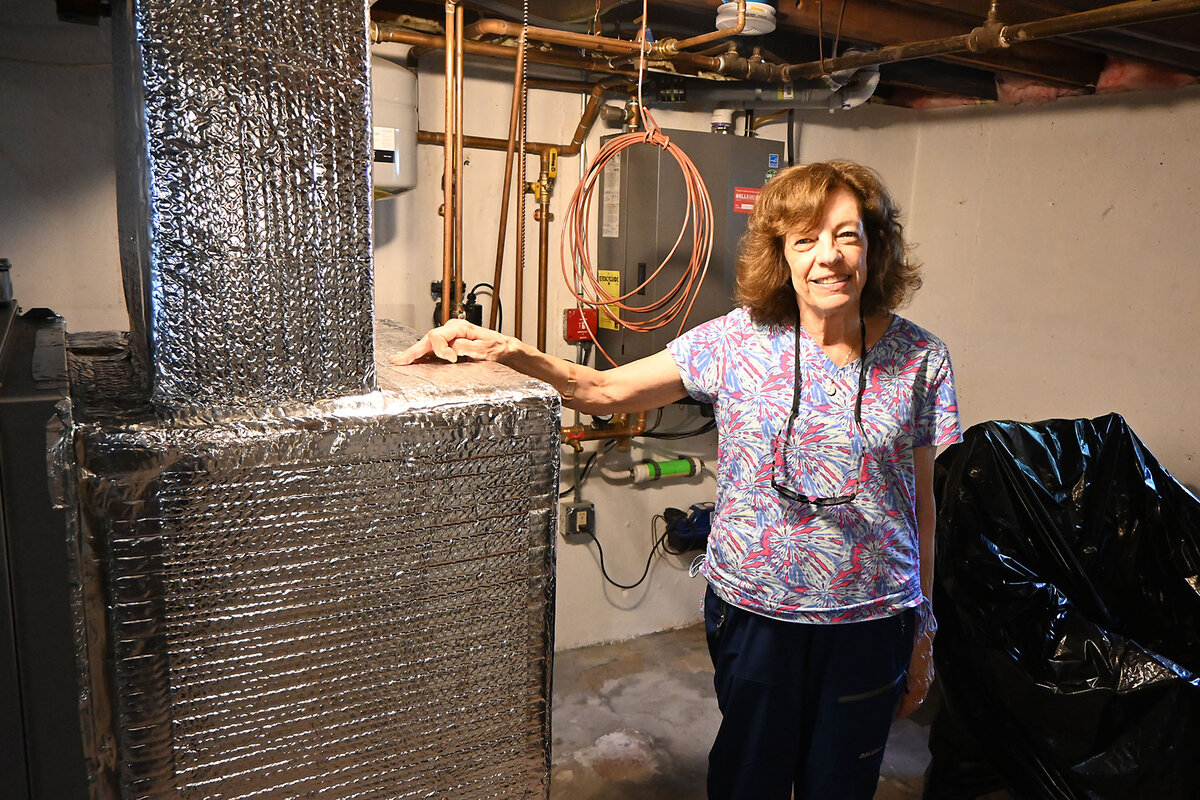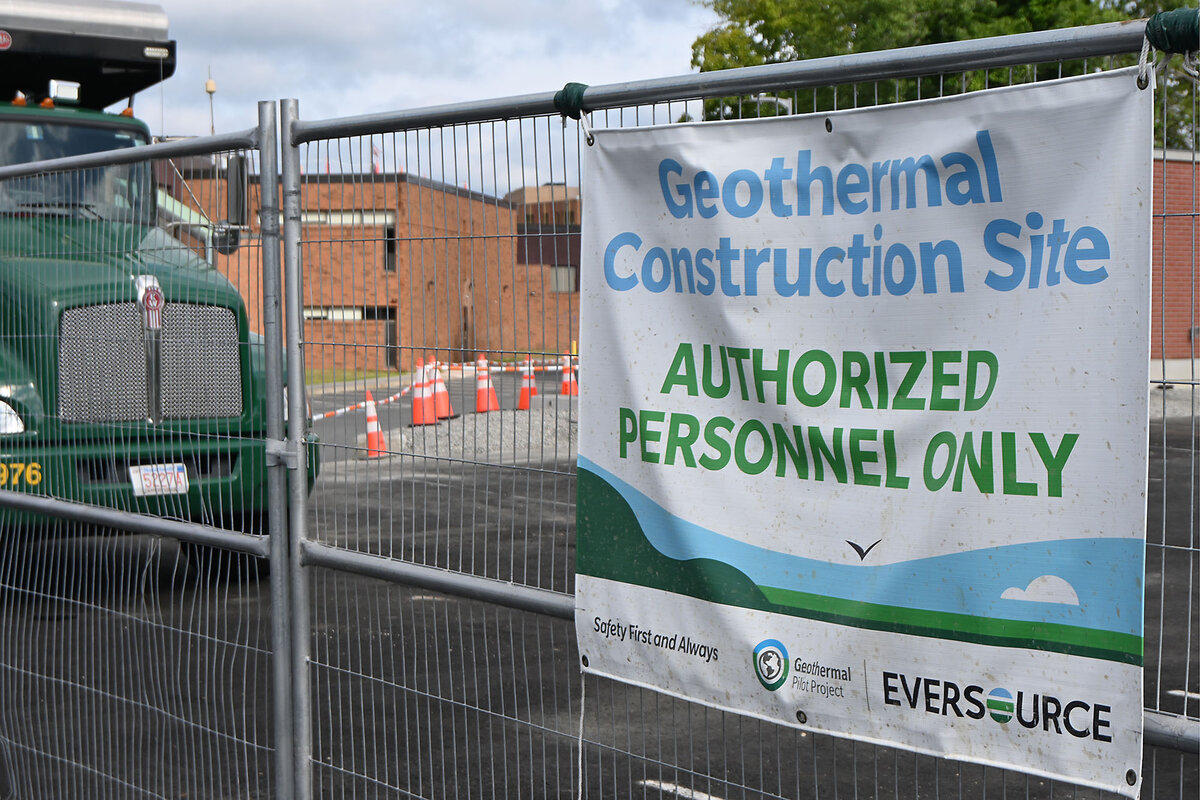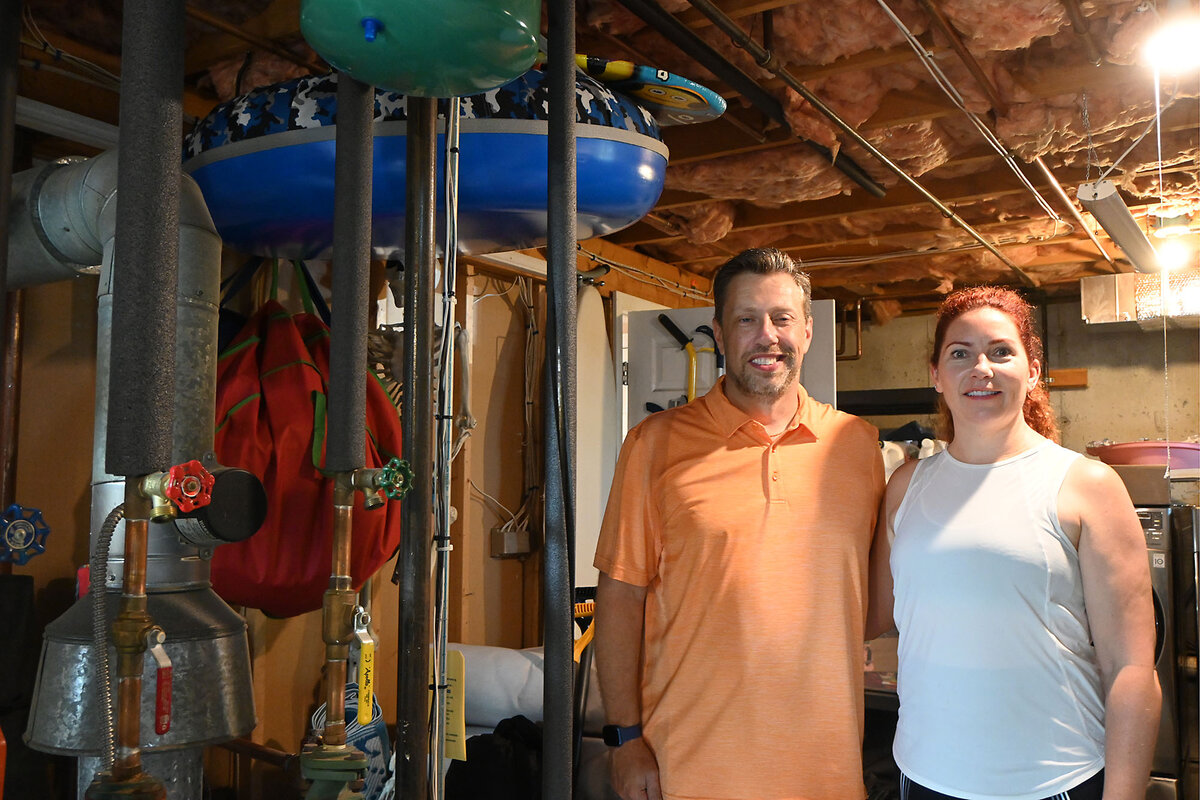How a gas company and environmentalists united on a first-of-its-kind geothermal project
Loading...
| Framingham, Mass.
In December 2016, William Akley sat down in his sprawling headquarters for the biggest gas utility in Massachusetts, Eversource. Across the table were three women from a group that had become increasingly troublesome to his company.
The group was Mothers Out Front, and it had been doing things like dressing up in orange costumes depicting gas flames and putting big signs where the company’s natural gas lines leaked into the air. Mr. Akley’s crews were scrambling to answer calls to fix hundreds of what they considered minor gas seepages.
An avalanche of letters from grandmothers organized by Mothers Out Front had convinced Mr. Akley, the president of gas operations at Eversource, to meet. It might be ugly. His aides asked if he should bring bodyguards or lawyers, he recalled later.
Why We Wrote This
A story focused onUtility companies and environmental activists are often pitted against each other. In this case, the two sides worked together to build the first program in the United States in which a major utility delivers clean geothermal energy.
But as the meeting started, Zeyneb Magavi and each of the other mothers calmly explained their passion to Mr. Akley: “I have three kids,” Ms. Magavi said. “I’m worried about climate change. And I’m worried about their future.”
When the women finished, there was a pause. Mr. Akley broke the silence. “I have three kids, too. I’m worried about climate change. And I am also worried about their future.”
“That was our little sliver of common ground that we started to grow,” recalls Ms. Magavi.
Mr. Akley agrees. “They came into that first meeting reaching across with their hands. It was about respect,” he marvels.
It was the start of an unlikely partnership that eventually became an audacious idea: to use heat from underground – instead of natural gas – to both cool and heat homes and buildings.
The test of that idea is now blinking on in Framingham, Massachusetts, 25 miles west of Boston. Eversource workers have buried a mile-long loop of plastic pipe underground and drilled 90 holes hundreds of feet deep to collect geothermal energy. They are now connecting the loop to heat and cool 36 buildings – homes, a fire station, and businesses.
It is the first U.S. trial of this innovative technology being provided to an entire neighborhood by a major utility. It’s the kind of scaled-up model that could bring a wholesale change to the nation’s infrastructure, replacing natural gas just as natural gas supplanted coal and oil in much of the United States.
“If we are really serious about decarbonization, we need to study all the possible options,” says Sergey Paltsev, a senior research scientist at the Massachusetts Institute of Technology. The trial in Framingham is “the right thing to do,” he says, and will be crucial to determine if the heat-pump system works well and is economically sensible for large numbers of consumers.
The Greeks and Romans used geothermal heat from the ground, and thousands of years earlier, Indigenous groups gathered around natural hot springs. But recent technology – primarily heat pumps – has made it possible to utilize a constant temperature collected by even shallow-buried pipes to both heat and cool. The development comes at an opportune time: Society is faced with urgent deadlines to stop burning fossil fuels.
“Utilities are reading the room and seeing a lot of excitement” about geothermal, says Ania Camargo, a senior manager for Building Decarbonization Coalition, a nationwide nonprofit seeking ways to limit carbon emissions. About 20 states have climate mandates to reach net-zero greenhouse gas emissions by 2050, she says, and about a third of those emissions come from buildings.
Nationally, 28 utilities have formed a coalition to study geothermal’s prospects, and 19 projects are in various stages of planning by utilities around the country, Ms. Camargo says. While the rush is on to create alternative sources of electricity, from renewable wind, solar, hydro and nuclear, geothermal and air heat pumps can replace old fossil fuel furnaces and costly air conditioners, supporters say.
Carol Canova looks at two pipes sticking through her basement concrete wall, a few feet from a new device the size of a furnace wrapped in silver insulation. “Everything’s ready to go,” says the retired schoolteacher in Framingham. “We are helping the environment tremendously.”
It started with a children’s book
Those involved say the pilot also shows another success: “It’s not just the technology,” says Ms. Magavi. “The magic of what we are doing is that groups are working together.”
It started, really, with a children’s book.
Kelsey Wirth remembers exactly the moment in 2010. She was sitting in bed with her daughter, then 5 years old, looking through a book on coral reefs and marine animals that they had picked up at the New England Aquarium.
“I realized that I was showing her things that she is unlikely to see as an adult,” because of the massive die-off of coral reefs from climate change, Ms. Wirth recalls. “I was so horrified for the very first time to really view the climate crisis through the lens of being a mom.”
Ms. Wirth wondered what she could do with her sense of despair about the future. She concluded, “My No. 1 job is to protect my children, so I can’t stay out of the fray.”
At a climate rally, she met Vanessa Rule, another mother, and their strategizing over coffees led to the first meeting of Mothers Out Front in Ms. Wirth’s Cambridge, Massachusetts, living room. The organization, vowing to combat climate change, exploded: It now has 45,000 members working on local issues in five states.
Ms. Magavi and other mothers around Boston joined forces with HEET, the Home Energy Efficiency Team. That nonprofit was cofounded by Audrey Schulman, who temporarily set aside her work writing adventure novels to advance the new cause. She had seized on a 2014 Boston University study that found vast leaks from the aging network of underground natural gas pipes in Boston, a problem for many old cities.
Ms. Schulman and volunteers pored over hundreds of pages of data in tiny type to create a Google map in 2015 with red dots showing all the leaks in Massachusetts. The map was jammed with thousands of red dots, showing seeping gas from cast-iron pipes often 100 years old.
Natural gas is primarily methane, a potent greenhouse gas, and the mothers began demonstrating for action to fix the leaks. The utilities ignored them. But soon the publicity over HEET’s maps and the Mothers Out Front protests “had their absolute horrified attention,” Ms. Schulman says. Eversource agreed to talk to the women.
While Mr. Akley says he was surprised at the mothers’ cooperative attitude at the meeting, Ms. Magavi says the mothers were thrilled by the end to have Mr. Akley’s agreement to seriously study the problem. Two other gas utilities joined the study.
“He took a leap of faith in us,” Ms. Schulman says. “He didn’t have to, in any way at all. And he did.”
Why can’t a utility deliver geothermal energy?
With Eversource’s cooperation, the mothers donned construction helmets and followed the gas utility crews around Boston to see how they work and collect data on leaks. They finished with a summit of 300 people that included the state’s three major utilities and top state officials.
“We had people in the room who have been arrested protesting gas pipelines and people who are constructing gas pipelines,” Ms. Magavi recounts. Eventually they agreed to jointly back state regulations to speed repair of the biggest leaks, which would significantly cut the methane emissions.
But even that would be enormously expensive. Ms. Schulman and Ms. Magavi realized replacing old iron pipes to fix just the worst leaks would cost billions of dollars. Ms. Magavi took the problem home and pondered. She has a physics degree, and she knew the difference in temperature from the ground to the air could be harnessed for energy.
Why, she wondered, couldn’t a utility deliver that kind of thermal energy rather than natural gas? “It just fit in,” she reasoned. “Why hasn’t anyone done it?”
She was relieved to find out others had used this geothermal system – most notably Colorado Mesa College. But no one had asked a utility to do it for a whole neighborhood of customers. She called up Mr. Akley. “I think our relationship is at a point where I can make another proposal to you,” she told the utility chief. “But you gotta take a deep breath.”
The key to the concept is a heat pump, a mechanism that can take air – or in this case water warmed in the ground – to warm a refrigerant gas inside the heat pump. The gas is then compressed to make it much hotter, to heat air circulating in the home during the winter.
In the summer, the refrigerant can be sprayed from a valve – with the same effect as a lawn sprinkler on a hot day – to cool air circulating through a home’s ducts. Many homeowners have bought air heat pumps to convert the temperature of air from outside, but using the constant temperature of the ground – about 50 to 55 degrees Fahrenheit in New England – works much more efficiently.
The setup could provide both heat and air conditioning, crucial in the warming summers, while lowering customers’ utility bills and cutting greenhouse gases.
There are drawbacks. Heat pumps alone cost $4,000 to $10,000 or more, not including the underground system. They may require air ducts in a home and can erase the gas bill but require using more electricity, which can be costly and is not carbon-free unless the electric supply is renewable. Proponents say to make sure this works for everyone, a utility-wide system is needed, perhaps with government subsidies or spread-out payments.
The concept seems promising for gas utilities, which already know how to construct heating systems, bury pipes, deal with thousands of customers, and spread the costs over time to ratepayers.
Mr. Akley listened to Ms. Magavi’s pitch. “I think she was shocked I was not running away,” he says. “I was really intrigued. I see this as being a huge game changer if we can make it affordable.”
But it was bold. When he, with HEET’s support, proposed a test site in 2019 to the state’s Department of Public Utilities, Mr. Akley says he was surprised it got approval. National Grid, another regional gas utility, has followed with plans for two other pilot projects in the state.
Geothermal “is a solution that a lot of different parties are very excited about, including labor,” says Caitlin Eichten, a senior policy assistant at Fresh Energy, a nonprofit that studies ways to end carbon dependence in Minnesota, which is a national leader in renewable energy policy. “We’re really hoping to build off of the work that’s being done in Massachusetts to advance thermal energy networks.”
Picking a test site
In 2021, Jennifer Mauchan, a financial planning manager, noticed two men from an Eversource car scoping out her Framingham neighborhood. They said they were looking for a test geothermal site.
They said they would need to dig trenches. “Dig away,” Mrs. Mauchan said.
The environmental benefits are attractive to her and her husband, Eric Mauchan, and there is a sweetener: For this pilot project, Eversource is paying for the heat pumps and all the home ductwork – worth about $120,000 just in his home, Mr. Mauchan says.
“We thought we had hit the house lottery,” says Mr. Mauchan, a biomedical salesperson, as he showed off the old furnace that will be replaced in his basement. Residential customers will pay from $7.30 to $9.75 per month for the geothermal energy.
The loop of pipe, buried 5 to 10 feet underground, was finished in June. Eversource and its contractors now swarm over homes and buildings in the neighborhood to equip them to turn on the connection, which the utility says will happen after testing in August. The test neighborhood was picked partly because it is an “environmental justice” community with a 57% minority population and an average household income of $20,400.
The state utility department wants to see if a utility-run network can bring geothermal heating and cooling to both low-income and other users, spreading out the high costs of drilling, pipes, and heat pumps.
Mr. Akley, who spent 40 years in the gas utility business, retired shortly after the June ceremony marking the completion of the underground infrastructure.
“I put it in the top of the list of the highlights of my career,” he says. “It’s a proud moment.” He says working with the activist mothers was special. “It brings some optimism for the future.”
Expanding the model
Richard Donnelly, who is director of energy innovation at the gas company Vermont Gas Systems, says many utilities understand they are in a fading business, and need to meet state climate goals that will phase out fossil fuels.
“If you are a gas utility and if you’re not at the table discussing this with the environmentalists, the policymakers, your customers, then you will probably be on the menu eventually,” he says.
Internationally, an arm of the World Bank has decided to fund a 30,000-home test and brought Ms. Magavi and an Eversource official to Turkey to talk about it there.
Ms. Magavi, now executive director of HEET, isn’t done. She’s dreaming on a large scale. Climate change has meant the seas have absorbed tremendous significant heat from burning fossil fuels. Why not use that heat – just as the heat beneath Framingham is being used – to warm and cool all of our cities? she asks.
“Right now we’re calculating how many large industrial heat pumps we’d have to put under the docks in Boston Harbor to restore it to a temperature the lobsters like, and how much of Boston could we heat with that?”
Audacious? Yes, she admits. But so was asking a gas utility to dig for heat in the ground.
“Why not,” she says, “go for it all?”
Editor's note: Audrey Schulman's title has been corrected to list her as a co-founder of HEET.











